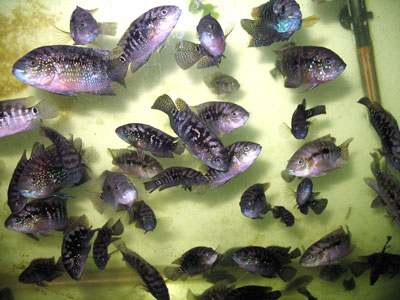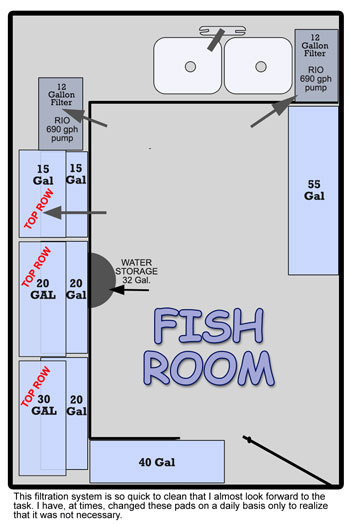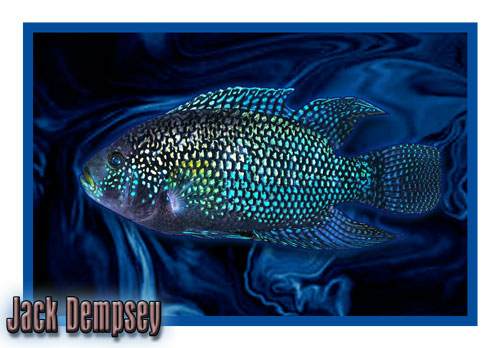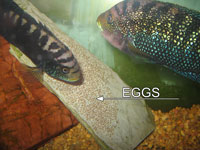| ~ LIP LOCK VIDEO ~ |
| THE WORLD OF JACK DEMPSEYS |
| THE WORLD OF JACK DEMPSEYS |
| VIDEO SHOWING THE FIRST 8 DAYS IN THE LIFE OF A BABY JACK DEMPSEY |
| This video was shot in August of 2007 and placed on the 'YOU TUBE' website soon after. This action packed video demonstrates just how intense the courting habits can be of two adult Jack Dempsey breeders. This pair has been together for almost three years. They were purchased together as 4 month old juveniles and have never been apart. I would estimate that they have spawned 18 times. |
| . |
 |
| MOM & DAD |
 |
| Rearing Jack Dempseys Can Be Challenging |
The Jack Dempsey, an aggressive and strong cichlid, is named after former heavyweight boxing champion Jack Dempsey who shared these same characteristics. It is a very hardy fish that is easy to care for, but due to its aggressive temperament, is not recommended for novice aquarists. In Spanish speaking regions in Central America where the Jack Dempsey is native to, it is called Mojarra castarrica or Riquiraqui. scientific name is Archocentrus octofasciatum. The species forms a part of the genus Cichlasoma in the Cichlidae family. Wild Jack Dempsey cichlids can be found in North and Central America where they inhabit a region that stretches from the Papaloap�n River in southern Mexico to the Hondurian Ulua River in Central America. The Jack Dempsey cichlid is often found in muddy canals, drainage ditches and swamps since it appreciates murky and slow flowing waters. In the coastal plains of Central America you will find warm and slow moving streams that are ideal for this cichlid. Since the wild Jack Dempsey cichlid lives in waters with a muddy or sandy bottom, it is naturally a good idea to use such substrates in the aquarium. Today, the Jack Dempsey cichlid has been introduced to waters outside its natural region by man. You can therefore find breeding populations of Jack Dempsey cichlids in the United States, Australia and Thailand. In Thailand, Jack Dempsey cichlids are produced in aquacultures for the aquarium trade. From these aquacultures, Jack Dempsey cichlids have frequently escaped into the wild since the first Jack Dempsey aquacultures were established in Thailand during the 1950s. In the United States and Australia, the Jack Dempsey cichlid populations most likely originate from specimens released by aquarists. The warm waters of Florida are today home to a wide range of tropical aquarium species from all over the world, including the Jack Dempsey cichlid. In Australia, the most notable Jack Dempsey populations are found in out-flow creeks in the state of Victoria and in cooling ponds used by a power plant. The Australian Jack Dempsey cichlid populations are however showing signs of decline. The Jack Dempsey cichlid is not included in the IUCN Red List of Threatened Species and you can find thriving populations of Jack Dempsey cichlids in its native region. Since its minimum population doubling time is less than 15 months, it is resilient towards over fishing. In the aquarium trade, the commercially bred Jack Dempsey cichlids are common. As mentioned above, the Jack Dempsey cichlid is easy to care for in the aquarium but considered unsuitable for inexperienced aquarists since they might find it difficult to handle its aggressive temperment and counteract violent behaviours. Jack Dempsey cichlids are often kept in their own aquariums instead of community aquariums or habitat aquariums, but you can keep this cichlid with other species if you select tank mates carefully. Avoid standard community aquarium species, since they tend to be peaceful and will become bullied by the Jack Dempsey cichlid. Aggressive species of similar size that can fend for themselves is a much better choice. Avoid keeping more than one Jack Dempsey cichlid in the aquarium, and avoid species that look similar to the Jack Dempsey cichlid since they may be perceived as enemies by the Jack Dempsey cichlid. It is also very important that the aquarium is large enough for the Jack Dempsey cichlid, and decorated in a way that makes it possible for the cichlid to claim a limited region as territory. Arranging a suitable home for a Jack Dempsey cichlid will require some dedication from the aquarists, but it is well worth it since the Jack Dempsey cichlid is an energetic and extremely beautiful fish that will add action as well as color to the aquarium. It will also adapt to most water conditions, so it is really not difficult to keep once you have learned how to master its aggressive temperament. In a well kept tropical aquarium your Jack Dempsey can live for 8-10 years. One way of calming down a quarrelsome Jack Dempsey cichlid is to keep the water temperature down. The recommended temperature range for a Jack Dempsey cichlid is 72-86� F (22-30� C), but many aquarists make sure that the temperature never goes above 78� F (25.5 degrees C) since warm water can increase the aggressiveness in some Jack Dempsey cichlids. Regardless of temperature, the Jack Dempsey cichlid will always claim its own territory and defend this part of the aquarium. As mentioned above, the Jack Dempsey cichlid can adapt to a wide range of different water conditions. The preferred pH range is however 7.0-8.0, and the dGH should be kept between 9 and 20. An adult Jack Dempsey cichlid can grow up to 10 inches (25 centimetres) long and must be provided with plenty of space. Do not house it in an aquarium smaller than 45 gallons (170 litres). If you plan to keep it with other fish, the recommended aquarium size will naturally depend on these species as well. In the wild, the Jack Dempsey cichlid inhabits densely grown waters. Plants are however often avoided in Jack Dempsey aquariums, since the Jack Dempsey likes to eat live plants and can destroy them. You can instead use flowerpots, caves, rocks and wood to form natural borders in the aquarium and make it possible for the Jack Dempsey cichlid to claim a limited territory. Since the Jack Dempsey cichlid is fond of digging, you should avoid substrate with sharp edges. A barren bottom, or a very thin substrate layer, is also unadvisable. Heavy objects that can injure fish if they fall should be placed directly on the glass, since they might fall when the Jack Dempsey cichlid digs around. You can usually train a Jack Dempsey cichlid into accepting most types of food, but it might take some time before the fish realizes that a new food type is actually edible. When a Jack Dempsey cichlid has understood that what you give it is actually food, it will usually be a happy eater. The wild Jack Dempsey cichlid feed mainly on insects, worms, crustaceans and fish and will appreciate such food types in the aquarium as well. Flake food and pellets can also be used; but pellets are usually a better idea since flakes are a bit too small large Jack Dempsey cichlids. A high-quality pellet can be a good base for the Jack Dempsey cichlid, but should ideally be combined with occasional treats of live food. Fish, earthworms, grasshoppers, shrimps, crayfish and small frogs are just a few examples of live food that your Jack Dempsey cichlid will like. When the Jack Dempsey cichlid is kept in an unplanted aquarium, it will need some vegetable matter in its diet, e.g. lettuce and plankton. If your Jack Dempsey cichlid suddenly changes its coloration, the alteration can have been caused by a number of factors. Sudden changes can be caused by mood swings, and stress can also make the Jack Dempsey cichlid dampen its colours. A varied and nutritious diet is also necessary if you want your Jack Dempsey cichlid to display really great colours. Age and health will also affect the coloration of a Jack Dempsey cichlid. If your Jack Dempsey cichlid becomes ill or experience a lot of stress in the aquarium, it can turn much paler than normal and look dull. The dots and bands will be less visible. A healthy, adult Jack Dempsey cichlid will typically feature a strong purple coloration with shimmering spots of blue, green and golden. You can clearly see a dark dot on each side of the body and tail, and the dorsal side features dark bands. If you closely at one scale, you will notice green or yellowish spots against the darker background. In older specimens, these spots will gradually become less visible. Really young specimens on the other hand will not have the purple coloration of the adult Jack Dempsey cichlids. Young Jack Dempsey cichlids are camouflaged by a pale grey or tan coloration, and have bleak turquoise dots. The mature male Jack Dempsey cichlid differs from the female, since the ends of his anal and dorsal fins are elongated and pointy. The Jack Dempsey cichlid is commercially bred in aquacultures and it is also possible to breed this cichlid in aquariums. It is considered a moderately hard species to breed in aquariums, and breeding Jack Dempsey cichlids will always be extremely aggressive. The Jack Dempsey cichlid will typically reach sexual maturity when it has grown to approximately 7-8 inches (18-20 centimeters). As mentioned above, many aquarists choose to keep the water temperature down in the aquarium to reduce hostile behaviours in the Jack Dempsey cichlid. If you want to spawn your Jack Dempsey cichlids, an increased temperature is however recommended. Breeding Jack Dempsey cichlids should always be kept in their own tank, or in an aquarium divided by glass or net, since the parents are highly aggressive during the breeding period. The Jack Dempsey cichlids will appreciate a breeding site in the aquarium in the form of a flat rock. The female Jack Dempsey cichlid can however deposit the eggs directly in the bottom substrate if there is not flat breeding site around. The adult couple should not be removed from the aquarium when the eggs have been deposited, because they are devoted parents that will care for the eggs. The parents will also dig a pit in the substrate in which they will place the larvae as soon as the eggs hatch. As the fry grows older, the parents will continue to protect them and care for them. The adult Jack Dempsey cichlids will even pre-chew food for their offspring as long as the young ones are too small to eat normal food. Check out the FISH LOG if you're interested in specific day-to-day activities of breeders caring for eggs and young hatchlings. --- END |
| Everything To Know About JACK DEMPSEYS |
| This is the same group of Jack Dempseys that you see in the picture at the top of this column. They range in age from 3 months to 5 months. If you continue to raise these little critters with no outlet for them, (except for the bathroom toilet) you will have to do as I did and simply pack them into a 55 gallon aquarium and/or any other tanks and buckets you have. I have to change 10% to 15% of the water daily. I also siphon out debris off the bottom on a daily basis plus clean the filter every third day. I don't have any gravel in these tanks making it easier to siphon off the bottom. I feed them 2 heavy feedings a day of Cichlid Sticks, flakes and Krill. Despite the crowded conditions, I have lost only 3 or 4 juveniles up to now. These critters are almost indestructible. |
| Seven day old Jack Dempseys seen here burrowing into gravel for either food or protection from predators. Their native waters have muddy or sandy bottoms so I tend to think they are searching out bits of food they find deep in the crevices. The danger is that if they get stuck, they will die of suffocation for the lack of oxygen in there. |
| Click to Enlarge |
| --- NEW --- |
| . |
| REARING JDs SUSPENDED TEMPORARILY |
| THE FISH ROOM Central filtration makes the upkeep of this system very easy and simple. There is also room for expansion in this small space, although it isn't clearly seen in this 2 dimensional diagram. Check out the FISH ROOM page. |
. |
| Technical Information (Jack Dempsey) Salinity Tolerance: This species appears to have a limited salinity tolerance. Dial and Wainright (1983) reported Jack Dempsey present in waters of up to 8 ppt, and absent from contiguous waters of higher salinity in Brevard County, Florida. Temperature Tolerance: The lower lethal temperature of Jack Dempsey was estimated at 8.0�C by Shafland and Pestrak (1983), upon which they placed Jacksonville as the probable northern limit for their range expansion in Florida. Jennings (1986), observed Jack Dempsey dying from cold stress, in a small creek in Alachua county, at 10-11�C. Reproduction and Fecundity Jack Dempsey are biparental substrate spawners. Females are more active early on in development, and are highly aggressive, even towards males, when guarding the egg clutch (Zvorykin, 1995). Approximately 500-800 eggs are spawned per clutch (Riehl and Baensch, 1991; Sakurai et al., 1992). Males become more active in guarding the fry as time goes on (Zvorykin, 1995). Both male and female are extremely aggressive towards other fish (Riehl and Baensch, 1991). Jennings (1986), believed the introduced population in Alachua county, Florida spawned in Spring. Trophic Interactions Jack Dempsey are omnivorous. In Florida, this species has been described both as herbivorous, feeding mainly on filamentous algae (Lee et al., 1980), and as omnivorous, opportunistically feeding on insect larvae and adults, crayfish, molluscs, and fish. |
| ANOTHER CICHLID WEBSITE |
| ANOTHER CICHLID WEBSITE |
| As time goes on the Jack Dempsey population remains the same. I've shut down all breeding and rearing young JDs for now. I do, however, have a new batch of baby fry in a 29 gallon tank in my bedroom. This aquarium houses the original pair of JDs and they still continue to mate. The video at the bottom of the page clearly shows how active this pair can be during courting. I sent this video on to "YOU TUBE" and have had over 28,400 VIEWS as of 8/01/09. It was placed on there at the end of August, 2007. Many comments have come in by way of E-mails asking questions about these two favorites of mine. Their colors can become very brilliant and several hobbyist have written to me asking if he was an Electric Blue JD. He is not, of course, but his colors can be incredibly beautiful. E-mail Central ( LIP LOCK VIDEO ) The e-mails continue to flow in at an ever increasing rate. This is mostly due to the VIDEO I placed on YOU TUBE on 8/07. The video can be viewed below. It shows how two breeding pairs of Jack Dempsey can get rather rough with each other durring courting. Watch and see what I mean. These guys can really get it on. Garden Pond Project So not too much has changed over the summer months. I spent most of my time in June and July building a double pond and waterfall in my back yard. Check out the before and after pictures at: "Garden Waterfall and Pond" I was very tempted to put a few JDs in the pond but decided against it. They might go after the resident frogs. I've started a new website project for the pond and waterfall. It won't be ready for the public untill October or later but if you'd like to take a peek, just click this link. THE BACK YARD POND Leaving Home Finally I have a few hundred Jack Dempsey juveniles that are soon to be visiting some pet stores in the area. I'll keep the numbers of juveniles I raise down to a managable number from here on. Beyond that, life remains the same in "The World of Jack Dempseys". |
| The World Of Jack Dempseys / Nandopsis Octofasciatum / Cichlasoma Octofasciatum |
| FRY TANK & FILTRATION In response to dozens of emails asking about the fry tank and it's filtration system, I have posted a diagram of it. If you have further questions please email me and I'll respond ASAP. CLICK HERE |
| An ongoing log of the progress of JD fry from hatching to adult. Interesting reading for the curious |
| About 500 eggs laid on slate |
Yes, that's right, another CICHLID FISH WEBSITE. This site was created to let other Cichlid enthusiasts know of my own personal experiences with the cichlid fish, Jack Dempsey. It's known under two different Latin names: (Nandopsis Octofasciatum / Cichlasoma Octofasciatum) I'm fascinated with their parenting drive and find many hours of enjoyment watching them protect their young from perceived enemies (me). I've used this site to post an ongoing log/diary of several hatches of baby Jack Dempseys from birth to the young juveniles. You'll also find information on nutrition requirements for the Jack Dempsey. What they like to eat and what kinds of food you should give them. Articles on breeding Jack Dempseys will be posted along with the experiences of those who have bred JDs. Diagrams and photos are just another feature that I wish to expand on. Check out the site and offer whatever suggestions you may have. It would be greatly appreciated. In the FEEDBACK column, you'll always find out what's happening here on this website. I was in the process of planning to breed angelfish but I'm running into great difficulty doing so. You can read more about that on the angelfish page. To provide good nutrition for the juvenile Angels, I'm maintaining 4 pair of Jack Dempsey breeders to supply me with nutritional eggs to help rear these angels into large, healthy specimens. My think-ing is to let the JDs lay eggs on the slate and then just take that egg layden slate and place in in the aquarium with the juvenile Angel fish. You can't find much better nutrition then that. My JD's are popping out hundreds of eggs for me every 6 to 7 weeks and I'm up to my eyeballs in juvenile Jack Dempseys. (see pic)==> I'll be expanding the information base on this website as time goes on. Jack Dempsey's are one of the most entertaining fish I have ever owned. They're smart, comical, energetic and even mean sometimes. All of which is a great combination for a delightful pet. It takes about 1 year for their colors and person-alities to develop. During their early stages of maturing they became lethargic much of the time. But now, I wouldn't be without them. |
|
|



